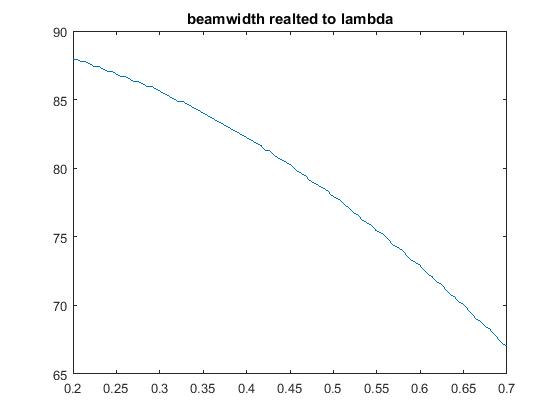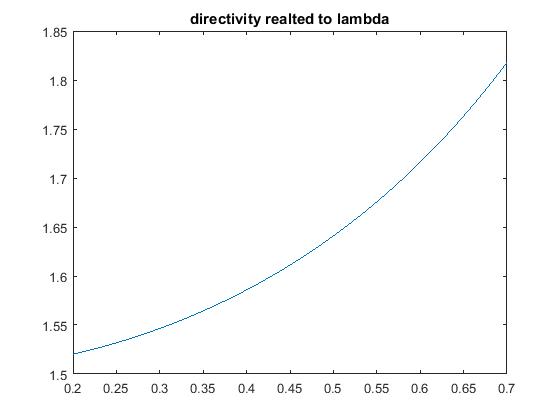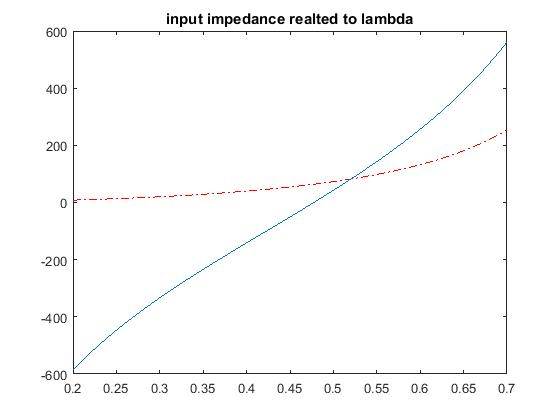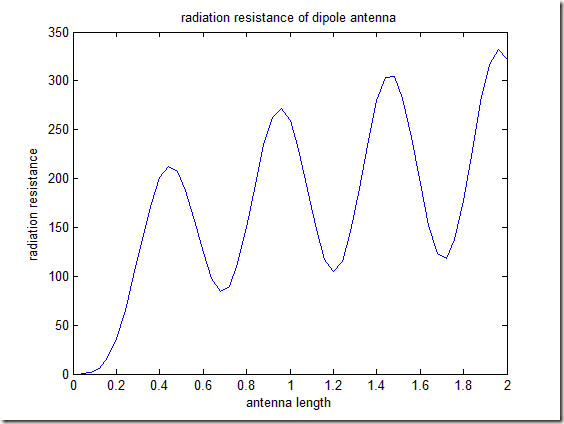Characteristics of dipole antenna.
%%
% characteristics of dipole antenna
% author : Leon
% email:yangli0534@yahoo.com
% url : www.cnblogs.com/hiramlee0534
%%
close all;
clear all;
clc;
global k;
global l;
M = 50;% numbers pattern of different length
N = 1000; % numbers of theta
theta = linspace(-pi, pi, N);
lamda = 1 ; % wavelength
k = 2*pi/lamda; % wave number
%%
% radiation pattern
fig = figure('color','white');
title('radiation pattern of dipole antenna');
for i = 1:1:M
l = i/M*2*lamda;
f =(cos(k*l*cos(theta))-cos(k*l))./sin(theta);
f = abs(f)/max(abs(f));
polar(theta,f);
xlabel(strcat('antenna length is ', num2str(l*2),' lamda'));
pause(0.1);
MF(i) = getframe(gcf);
end
%%
% radiation resistance
for i = 1:1:M
l = i/M*2*lamda;
r(i) = quad('Fr',0, pi);
end
figure;
plot((1:1:M)/M*2*lamda,r);
title('radiation resistance of dipole antenna');
xlabel('antenna length');
ylabel('radiation resistance');



1 %% 2 %dipole antenna calc 3 %author:Li Yang 4 % email: yangli0534@yahoo.com 5 6 function [beamwidth,D0,Rr,Rin,Xin]=dipole_pattern(len,flag ); 7 8 format long 9 10 if nargin<2 11 if nargin == 0 12 error('too few argument') 13 else 14 flag = 0; 15 end 16 end 17 18 N = 1000; 19 theta = linspace(0,pi,N)+pi/5/N; 20 phi = linspace(0,2*pi,N); 21 22 I0 = 1 ;% constant current 23 freq = 1e9 ;% frequency 24 e0 = 8.854187817e-12; 25 u0 = 4*pi*1e-7; 26 c = 1.0/sqrt(e0*u0); 27 lambda = c/freq; 28 l = len*lambda;%length 29 rad = 0.001*lambda;%radius of the dipole 30 imp = sqrt(u0/e0); 31 k = 2*pi/lambda; 32 r = 10; 33 if k*r <1 34 error('kr < 1'); 35 end 36 %% 37 %electric field intensity and magnetic field intensity in far-field region 38 E0 = 1i*imp*I0/(2*pi*r)*exp(-1i*k*r)*(cos(k*l/2*cos(theta))-cos(k*l/2))./sin(theta);%the theta component of e field 39 H0 = 1i*I0/(2*pi*r)*exp(-1i*k*r)*(cos(k*l/2*cos(theta))-cos(k*l/2))./sin(theta);% the phi component of h compoent 40 %plot(theta,E0) 41 %% 42 %power density 43 Wav = 0.5*real(E0.*conj(H0)); 44 Wavx= (Wav.*sin(theta))'*cos(phi); 45 Wavy= (Wav.*sin(theta))'*sin(phi); 46 Wavz= repmat((Wav.*cos(theta))',1,N); 47 Wavc= repmat((Wav)',1,N); 48 if flag == 1 49 figure; 50 surf(Wavx,Wavy,Wavz,Wavc); 51 shading interp; 52 light; 53 lighting gouraud; 54 colorbar; 55 title('average power density'); 56 end 57 %% 58 %radiation intensity 59 U =r^2*Wav; 60 Ux= (U.*sin(theta))'*cos(phi); 61 Uy= (U.*sin(theta))'*sin(phi); 62 Uz= repmat((U.*cos(theta))',1,N); 63 Uc= repmat((U)',1,N); 64 if flag == 1 65 figure; 66 surf(Ux,Uy,Uz,Uc); 67 shading interp; 68 light; 69 lighting gouraud; 70 colorbar; 71 title('radiation intensity'); 72 end 73 %Prad = imp*pi/3*(I0*l/lambda)^2; 74 Prad = 0; 75 for i = 1:1:N 76 Prad = Prad +U(i)*sin(theta(i))*(theta(2)-theta(1))*2*pi; 77 end 78 D = 4*pi*U/Prad; 79 D0 = max(D); 80 Dx= (D.*sin(theta))'*cos(phi); 81 Dy= (D.*sin(theta))'*sin(phi); 82 Dz= repmat((D.*cos(theta))',1,N); 83 Dc= repmat((D)',1,N); 84 if flag == 1 85 figure; 86 surf(Dx,Dy,Dz,Dc); 87 shading interp; 88 light; 89 lighting gouraud; 90 colorbar; 91 title('directivity'); 92 end 93 94 95 % ND = 10*log10(D(1:round(N/2))/max(D(1:round(N/2)))); 96 ND = 10*log10(D/max(D)); 97 peak = find(ND==max(ND)); 98 NDD= abs(ND+3); 99 left = find(NDD(1:peak)==min(NDD(1:peak))); 100 find((NDD)==min(NDD)); 101 right = find(NDD(peak:end)==min(NDD(peak:end)))+ peak-1; 102 beamwidth = (theta(right)-theta(left))/pi*180; 103 if flag == 1 104 figure; 105 plot(theta/pi*180,ND); 106 title('E plane directivity pattern'); 107 end 108 str = strcat('3dB beam width is ',num2str(round(beamwidth*100)/100), '° '); 109 110 E_dB=10*log10(abs(E0)/max(abs(E0))); 111 E_dB(E_dB<=-60)=-60; 112 if flag == 1 113 figure; 114 polar_dB(theta*180/pi,E_dB,-60,0,4); 115 title('Elevation plane normalized amplitude pattern (dB)','fontsize',16); 116 end 117 D_dB=10*log10(D); 118 D_dB(D_dB<=-60)=-60; 119 if flag == 1 120 figure; 121 polar_dB(theta*180/pi,D_dB,-60,max(D_dB),4); 122 title(strcat('Elevation plane directivity pattern (dB):',str),'fontsize',12); 123 end 124 %text(60,0,str) 125 126 Rr = 2*Prad; 127 Rin = Rr/(sin(k*l/2)^2); 128 Xm=30*(2*si(k*l)+cos(k*l)*(2*si(k*l)-si(2*k*l))- ... 129 sin(k*l)*(2*ci(k*l)-ci(2*k*l)-ci(2*k*rad^2/l))); 130 Xin=Xm/(sin(k*l/2))^2; 131 132 function [y]=si(x); 133 v=linspace(0,x/pi,500); 134 dv=v(2)-v(1); 135 y=pi*sum(sinc(v)*dv); 136 137 function [y]=ci(x); 138 v=linspace(0,x/(2*pi),500); 139 dv=v(2)-v(1); 140 y1=2*pi*sum(sinc(v).*sin(pi*v)*dv); 141 y=.5772+log(x)-y1; 142

